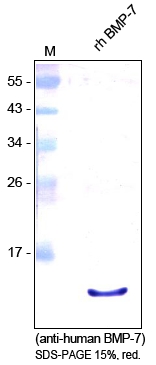BMP7 Rabbit Polyclonal Antibody
Other products for "BMP7"
Specifications
| Product Data | |
| Applications | WB |
| Recommended Dilution | Western Blot: 2-5 µg/ml |
| Reactivities | Human |
| Host | Rabbit |
| Isotype | IgG |
| Clonality | Polyclonal |
| Immunogen | Highly pure (>95%) recombinant Human BMP-7 (Ala316-His431) derived from E. coli. |
| Specificity | Recognizes Human BMP7. |
| Formulation | PBS, pH 7.2 State: Purified State: Lyophilized purified IgG fraction |
| Reconstitution Method | Centrifuge vial prior to opening. Restore in sterile water to a concentration of 0.1-1.0 mg/ml. |
| Purification | Protein A Chromatography |
| Conjugation | Unconjugated |
| Storage | The lyophilized antibody is stable at RT for up to 1 month. The reconstituted antibody is stable for at least two weeks at 2-8°C. Frozen aliquots are stable for at least 6 months when stored at -20°C. Avoid repeated freeze-thaw cycles! |
| Gene Name | bone morphogenetic protein 7 |
| Database Link | |
| Background | Bone morphogenetic protein 7 (BMP-7), also known as osteogenic protein 1 (OP1), is a widely expressed TGFβ superfamily member with important functions during embryogenesis, in the adult, and in disease (1,2). Human BMP-7 is synthesized with a 29 amino acid (aa) signal sequence, a 263 aa propeptide, and a 139 aa growth factor domain (3). The growth factor domain of human BMP-7 shares 98% aa sequence identity with mouse and rat BMP-7. The BMP-7 propeptide is cleaved intracellularly but often remains associated with the mature C-terminus. Based on in vivo and in vitro studies, BMP-7 has the potential to be secreted as a disulfide-linked mature homodimer, or particularly as a heteromeric complex that consists of two propeptides noncovalently associated with a mature disulfide linked homodimer (5,6). The presence of the propeptides in BMP-7 appears to stabilize the molecule and provide a docking mechanism for extracellular storage on molecules such as fibrillin1 and 2 (5,6). The propeptides themselves do not impart latency to the complex. BMP-7 binding to type II receptors rapidly displaces the prodomain: mature molecule interaction and has no effect on activity. But it is suggested that immobilized BMP-7 (via prodomain:fibrillin) is inactive, allowing for possible long term storage of the molecule (6). BMP-7 interacts with the type 2 receptors Activin RIIA, Activin RIIB, and BMPRII and the type 1 receptors Activin RIA, BMPRIA, and BMPRIB (2,6). BMP-7 may also be processed into a disulfide-linked heterodimer with either BMP-2 or BMP-4. Such complexes may show increased potency and range of activity compared to BMP7 homodimers (7-9). BMP-7 plays a role in a variety of organ systems. It promotes new bone formation and nephron development (10,11), inhibits the branching of prostate epithelium (12), and antagonizes epithelial mesenchymal transition (EMT) (13-15). In pathological conditions, BMP-7 inhibits tumor growth and metastasis (14), ameliorates fibrotic damage in nephritis (13), and promotes neuro regeneration following brain ischemia (16). |
| Synonyms | BMP-7, Bone morphogenetic protein 7, OP1, Osteogenic protein 1 |
| Reference Data | |
| Protein Families | Adult stem cells, Cancer stem cells, Druggable Genome, Embryonic stem cells, ES Cell Differentiation/IPS, Induced pluripotent stem cells, Secreted Protein, Stem cell relevant signaling - TGFb/BMP signaling pathway |
| Protein Pathways | Cytokine-cytokine receptor interaction, Hedgehog signaling pathway, TGF-beta signaling pathway |
Documents
| Product Manuals |
| FAQs |
| SDS |
{0} Product Review(s)
0 Product Review(s)
Submit review
Be the first one to submit a review
Product Citations
*Delivery time may vary from web posted schedule. Occasional delays may occur due to unforeseen
complexities in the preparation of your product. International customers may expect an additional 1-2 weeks
in shipping.






























































































































































































































































 Germany
Germany
 Japan
Japan
 United Kingdom
United Kingdom
 China
China



